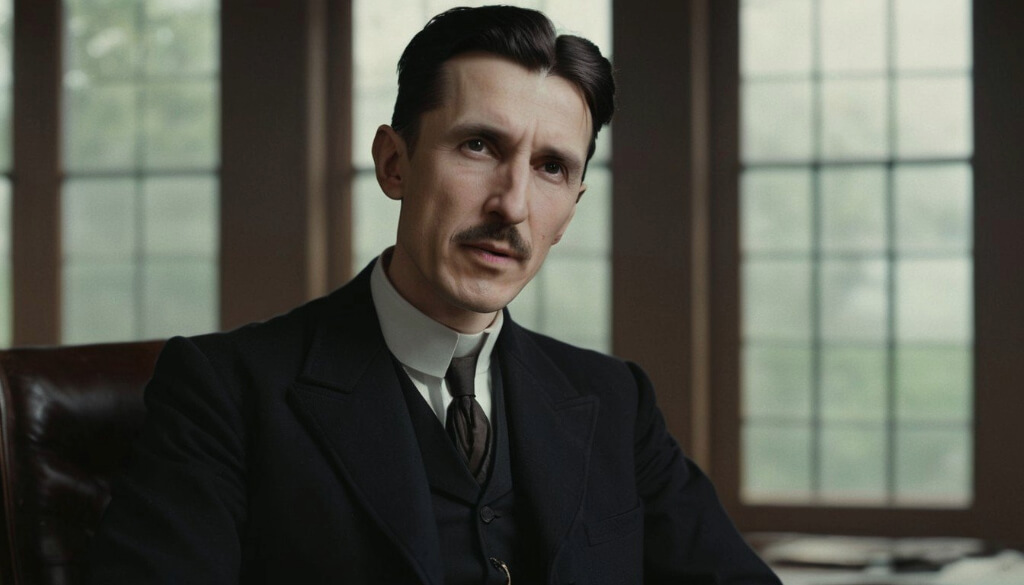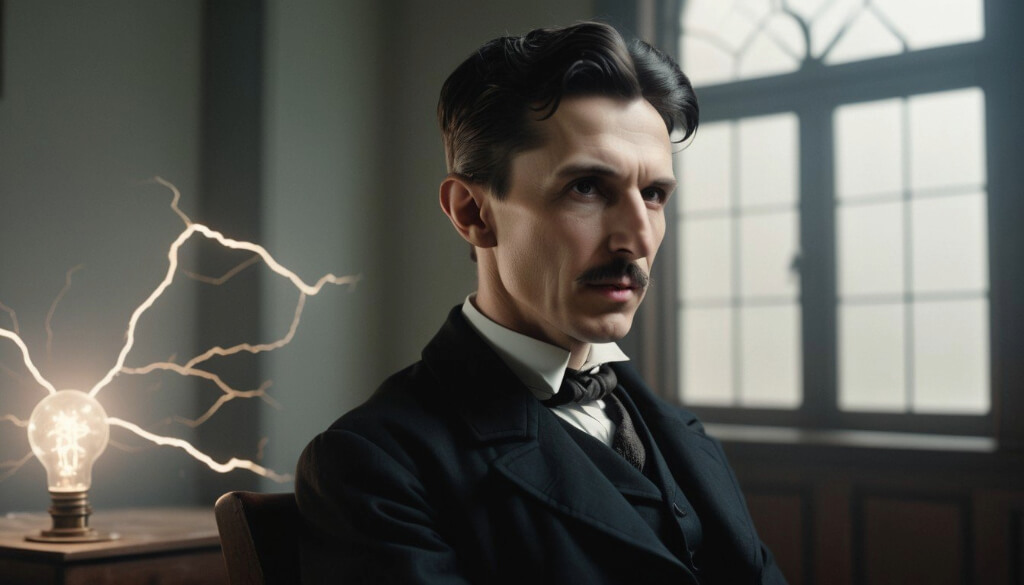Nikola Tesla, a name synonymous with innovation and brilliance, left an indelible mark on the world through his revolutionary inventions and pioneering ideas. Born in the Austrian Empire in 1856, Tesla’s journey from a small village to becoming one of the greatest minds in history is a testament to his unparalleled genius.

Early Life And Education
In the quaint village of Smiljan, young Nikola Tesla displayed an early fascination with the mysteries of the natural world. Raised in a Serbian family, Tesla’s inquisitive mind led him to pursue an education in engineering and physics. His journey began at the Austrian Polytechnic in Graz, where he delved into the principles that would shape the future of electrical engineering.
Tesla’s Innovations And Inventions
As the world grappled with the War of Currents in the late 19th century, Tesla emerged as a key figure in the battle between alternating current (AC) and direct current (DC) systems. His groundbreaking work in developing the AC system not only triumphed over Thomas Edison’s DC, but it laid the foundation for the modern power distribution systems we rely on today. The name Nikola Tesla became synonymous with electrical innovation.
Among Tesla’s many inventions, the Tesla Coil stands out as a marvel of engineering. This high-voltage transformer paved the way for wireless transmission of energy, a concept far ahead of its time. Tesla’s vision extended beyond practical applications, reaching into the realms of wireless communication and energy transfer on a global scale.
Struggles And Challenges
Despite his brilliance, Nikola Tesla faced numerous challenges, both financial and personal. His unyielding pursuit of innovation often left him in dire straits, with financial difficulties overshadowing his achievements. The clash with Thomas Edison during the War of Currents further highlighted the struggles Tesla faced in gaining recognition for his contributions.
Tesla’s Vision For The Future
Nikola Tesla’s visionary ideas extended beyond the constraints of his era. He envisioned a future where wireless technology would connect the world, and renewable energy sources would power our societies. Today, as we witness the fruition of some of his predictions, it’s clear that Tesla’s forward-thinking mindset continues to shape the technological landscape.
Legacy And Influence
The impact of Nikola Tesla on the field of electrical engineering is immeasurable. His inventions laid the groundwork for the electrified world we inhabit, and his legacy endures through the countless innovations inspired by his work. Despite facing challenges during his lifetime, Tesla’s influence extends far beyond his era, and his name remains synonymous with innovation.
Misconceptions And Controversies
In the annals of history, myths and misconceptions have surrounded Nikola Tesla. Some claim he was an eccentric recluse, while others question the authenticity of his inventions. Dispelling these myths is essential to understanding the true extent of Tesla’s contributions. The controversies surrounding his relationships with contemporaries add layers of complexity to his story.
Personal Life And Eccentricities
Beyond his scientific endeavors, Tesla’s personal life and eccentricities contribute to the enigmatic aura surrounding him. From his meticulous daily routines to his fondness for feeding pigeons in New York City parks, Tesla’s eccentricities have become legendary. These idiosyncrasies offer glimpses into the complex personality of the man behind the inventions.
The life and work of Nikola Tesla continue to captivate and inspire. His brilliance, coupled with a relentless pursuit of innovation, has left an enduring legacy. The name Nikola Tesla remains etched in the annals of scientific history, a symbol of unwavering dedication to the pursuit of knowledge and progress.
Tesla’s Contribution To Electricity
Nikola Tesla’s name resonates throughout history as one of the most influential figures in the field of electricity. His contributions have had a profound impact on the way we generate, transmit, and utilize electrical power, fundamentally shaping the modern world. In this article, we’ll delve into Tesla’s remarkable life and explore the inventions and discoveries that have cemented his legacy.
Early Life And Influences
Nikola Tesla’s journey into the realm of electricity was profoundly influenced by his upbringing and early experiences. Born in 1856 in Smiljan, Croatia, then part of the Austro-Hungarian Empire, Tesla was raised in a family deeply rooted in Serbian heritage. His father, Milutin Tesla, was a Serbian Orthodox priest and his mother, Djuka Tesla, was an inventor in her own right, known for her skill in creating household appliances.
From a young age, Tesla demonstrated an insatiable curiosity and a remarkable aptitude for mathematics and science. His childhood was marked by a fascination with the natural world, particularly with electricity and magnetism. Tales of lightning storms and the mesmerizing glow of the aurora borealis captured his imagination, igniting a lifelong passion for understanding the mysteries of electricity.

Tesla’s formal education provided him with a solid foundation in engineering and physics. After completing his primary education in Croatia, he attended the Technical University of Graz in Austria and later studied electrical engineering at the University of Prague. It was during his university years that Tesla first encountered the works of influential scientists such as Michael Faraday and Johann Wilhelm Hittorf, whose experiments with electricity inspired him to pursue a career in electrical engineering.
However, it was not just academic influences that shaped Tesla’s early life. His experiences working as a telegraph operator and engineer exposed him to the practical applications of electricity, giving him invaluable insight into the workings of electrical systems and machinery. These hands-on experiences fueled Tesla’s ambition to push the boundaries of electrical engineering and innovation.
Despite facing financial difficulties and familial opposition to his chosen path, Tesla remained steadfast in his pursuit of knowledge and innovation. His determination and unwavering belief in the power of science to transform the world propelled him forward, setting the stage for the remarkable inventions and discoveries that would define his legacy in the field of electricity.
In summary, Nikola Tesla’s early life and influences played a crucial role in shaping his trajectory as a pioneering figure in the field of electricity. From his childhood fascination with natural phenomena to his formal education and practical experiences, every aspect of Tesla’s upbringing contributed to his development as a visionary inventor and engineer.
Inventions And Discoveries
Tesla’s most notable contribution to electricity lies in the development of the Alternating Current (AC) system. Unlike Direct Current (DC), AC can be transmitted over long distances with minimal loss of power, revolutionizing the distribution of electricity. Tesla’s advocacy for AC led to its widespread adoption, laying the foundation for modern power grids.
The Tesla Coil stands as another testament to his ingenuity. This device, capable of producing high-voltage, high-frequency alternating currents, has found applications in fields ranging from telecommunications to entertainment. Its invention marked a significant advancement in electrical engineering and paved the way for numerous technological innovations.
Tesla’s experiments with wireless transmission of power further exemplify his visionary approach to electricity. While his dream of global wireless communication through the Wardenclyffe Tower remained unrealized, his work laid the groundwork for modern wireless technologies, including radio and Wi-Fi.
In addition to these groundbreaking inventions, Tesla also contributed to the development of the induction motor, remote control technology, and Tesla turbines, each playing a crucial role in advancing electrical engineering and industry.
Tesla’s Vision For The Future
Nikola Tesla’s visionary ideas extended far beyond the confines of his lifetime, encompassing dreams of harnessing the power of nature for the betterment of humanity. Throughout his career, Tesla’s work was driven by a profound belief in the potential of science and technology to revolutionize the world and improve the lives of people everywhere.
One of the most iconic embodiments of Tesla’s vision for the future was the Wardenclyffe Tower, a monumental structure intended to facilitate global wireless communication and provide free and accessible energy to the world. Conceived in the early 20th century, the Wardenclyffe Tower was to serve as the centerpiece of Tesla’s ambitious plan to transmit electricity wirelessly across vast distances, eliminating the need for traditional power lines and making energy accessible to all.
At the heart of Tesla’s vision was the concept of tapping into the Earth’s natural resources to generate power on a scale never before imagined. He envisioned harnessing the Earth’s electromagnetic field to create a virtually limitless source of energy, free from the constraints of fossil fuels or conventional power generation methods. Tesla believed that by tapping into this abundant source of energy, humanity could usher in a new era of prosperity and progress, free from the limitations imposed by finite resources.
Beyond the practical applications of his inventions, Tesla’s vision for the future encompassed broader philosophical and humanitarian ideals. He envisioned a world where technology served as a force for unity and enlightenment, transcending borders and divisions to connect people in ways previously unimaginable. Tesla believed that through the power of communication and collaboration, humanity could overcome its greatest challenges and achieve unprecedented levels of prosperity and understanding.
Despite the failure of the Wardenclyffe Tower project and many of his other ambitious endeavors, Tesla’s vision for the future continues to inspire researchers, engineers, and innovators around the world. His ideas laid the groundwork for numerous technological advancements, from wireless communication to renewable energy, that continue to shape the modern world.
In many ways, Tesla’s vision for the future remains as relevant today as it was during his lifetime. As we grapple with pressing global challenges such as climate change and energy scarcity, the principles of sustainability and innovation that guided Tesla’s work offer valuable insights and inspiration. By embracing Tesla’s vision and building upon his legacy, we have the opportunity to create a brighter, more sustainable future for generations to come.
Impact On Society And Industry
Tesla’s contributions to electricity have had a profound impact on society and industry. The widespread adoption of AC power systems facilitated the electrification of the world, powering industries, homes, and transportation. His inventions laid the groundwork for modern power grids, enabling the efficient distribution of electricity to communities around the globe.
Despite facing numerous challenges and controversies, including the infamous “War of Currents” with Thomas Edison, Tesla’s perseverance and visionary ideas ultimately triumphed, leaving an indelible mark on the world.
Recognition And Legacy
Nikola Tesla’s recognition and legacy have undergone a significant evolution since he died in 1943. While he spent much of his later life in relative obscurity, Tesla’s contributions to science and engineering have since garnered increasing appreciation and acclaim, cementing his status as one of history’s most influential inventors.

In the years following his passing, efforts to preserve and promote Tesla’s legacy gained momentum, fueled by a growing recognition of his pioneering work in the field of electricity. Museums, libraries, and educational institutions around the world began to honor Tesla’s achievements, collecting artifacts, documents, and memorabilia related to his life and work.
One of the key milestones in the recognition of Tesla’s legacy was the establishment of the Nikola Tesla Museum in Belgrade, Serbia, in 1952. This museum, located in Tesla’s hometown of Smiljan, serves as a tribute to his life and achievements, housing a vast collection of Tesla’s personal belongings, scientific instruments, and original documents. The museum has become a pilgrimage site for admirers of Tesla’s work, attracting visitors from around the globe who come to pay homage to the man often referred to as the “father of electricity.”
In addition to physical monuments and institutions, Tesla’s legacy is also celebrated through various awards, honors, and commemorations. The Nikola Tesla Award, established in 1976 by the Institute of Electrical and Electronics Engineers (IEEE), recognizes outstanding contributions to the field of electrical engineering and honors Tesla’s pioneering spirit and innovative achievements. Similarly, numerous streets, parks, and landmarks bear Tesla’s name, serving as enduring reminders of his enduring impact on the world.
Beyond formal recognition, Tesla’s legacy continues to resonate in the realms of science, technology, and popular culture. His inventions and ideas have inspired countless generations of scientists, engineers, and inventors, shaping the course of technological progress and innovation. From the development of the modern power grid to the advent of wireless communication and renewable energy technologies, Tesla’s influence can be felt in virtually every aspect of modern life.
Perhaps most importantly, Tesla’s legacy serves as a testament to the power of vision, creativity, and perseverance in the pursuit of knowledge and progress. Despite facing numerous challenges and setbacks throughout his life, Tesla remained steadfast in his commitment to advancing the frontiers of science and technology, leaving behind a legacy that continues to inspire and motivate individuals around the world.
In conclusion, Nikola Tesla’s recognition and legacy stand as a testament to his enduring impact on the world. From his groundbreaking inventions to his visionary ideas for the future, Tesla’s contributions to science and engineering have left an indelible mark on the course of human history. As we continue to reap the benefits of his pioneering work, let us remember and honor the legacy of this remarkable innovator for generations to come.
Final Thoughts
In conclusion, Tesla’s contribution to electricity cannot be overstated. His inventions and theories have shaped the modern world in profound ways, laying the foundation for the electrified society we live in today. As we continue to reap the benefits of his visionary ideas, let us remember and honor Nikola Tesla’s enduring legacy.
FAQs
What Were Nikola Tesla’s Most Famous Inventions?
Tesla’s most famous inventions include the AC electrical system, the Tesla Coil, the induction motor, and the Tesla Turbine. These innovations revolutionized the field of electrical engineering.
How Did Nikola Tesla Influence Modern Technology?
Tesla’s contributions laid the foundation for modern power distribution systems, wireless communication, and various electrical devices. His ideas continue to shape the technological landscape today.
Was Nikola Tesla Recognized During His Lifetime?
Despite his groundbreaking work, Tesla faced financial difficulties and struggled for recognition. His contributions gained more acknowledgment posthumously, as the significance of his inventions became widely recognized.
What Was Tesla’s Most Significant Contribution To Electricity?
Tesla’s development of the Alternating Current (AC) system revolutionized the distribution of electrical power, enabling its widespread adoption and paving the way for modern power grids.
What Challenges Did Tesla Face During His Lifetime?
Tesla encountered numerous challenges, including financial struggles, patent disputes, and conflicts with rival inventors such as Thomas Edison. Despite these obstacles, he persevered in his quest to advance electrical engineering and technology.
How Did Tesla’s Inventions Impact Society And Industry?
Tesla’s inventions facilitated the electrification of the world, powering industries, homes, and transportation. His contributions laid the groundwork for modern power grids and revolutionized the way we generate, transmit, and utilize electricity.
Also Read: The Shocking Wonders Of Tesla Coils Revealed
